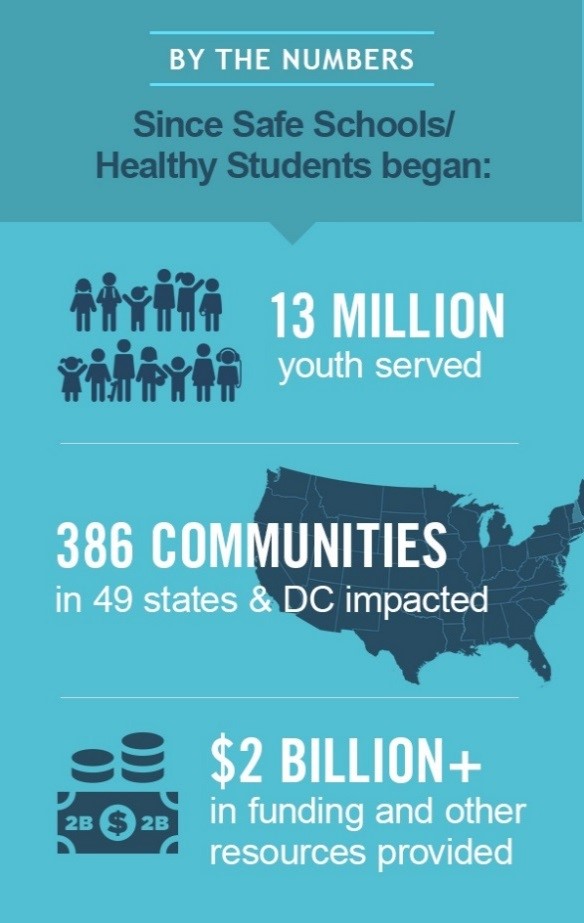Lower rates of violence. Reductions in drug abuse. Increased availability and delivery of mental health services and family support. After more than a decade and a half, these are the types of successes the Safe Schools/Healthy Students (SS/HS) Initiative has had in cities, towns, counties, and states across the United States.
Safe Schools/Healthy Students: A Model for Collaboration and Sustainability

Safe Schools/Healthy Students was formed in 1999 following a series of deadly school shootings and heightened concern for the safety and mental health of the nation’s children. It originally started as a federal grant program developed by the U.S. Departments of Education, Health and Human Services, and Justice. At the time, SS/HS was an unprecedented collaboration among federal agencies.
From the beginning, the goals for this Initiative have been to ensure:
- Students feel safe in schools, free from violence and bullying to enhance their ability to learn.
- Students avoid drugs, alcohol, and violence to help them live healthier, safer lives.
- Students have access to the mental health services they need to help them cope with challenges in the classroom and at home.
- Students don’t feel isolated, because they can connect with their schools and communities.
The SS/HS Initiative, now led by the Substance Abuse and Mental Health Services Administration (SAMHSA), recognizes that achieving these goals requires a comprehensive approach, because many factors can contribute to youth violence, including early childhood experiences, family life, mental health, and substance abuse issues. Thus, SS/HS draws on best practices and the latest knowledge across education, justice, social services, and mental health to create safe, drug-free, and respectful environments for learning and promote the behavioral health of children and youth. Because of the success of the 365 local SS/HS Initiatives, SAMHSA expanded the model to a state program in which three local communities within each of seven participating states work with the state to implement and expand the program.
The Initiative fosters collaboration and partnerships between schools and organizations such as city government, community youth programs, faith-based organizations, and substance abuse prevention organizations. These joint, multi-disciplinary efforts allow organizations to leverage resources and share expertise. SS/HS also provides tools—such as the SS/HS Framework and online learning modules and webinars —to help grantees and communities systematically plan and sustain their work by implementing strategic, comprehensive, evidence-based approaches; identifying more cost-effective service delivery methods; and securing a broader funding base.
Evidence of Success
|
Highlights of the Safe Schools/Healthy Students Evaluation – 2005 and 2006 grantee cohorts |
||
|
A 5-year study of 59 grantees whose Safe Schools/Healthy Students funding began in 2005 and 2006 found the model is working. Violence and drug use in participating schools decreased, mental health services increased, and school staff reported feeling better prepared to identify students who needed mental health support. See the text box, Highlights of the Safe Schools/Healthy Students Evaluation, for more details.[1] SS/HS also increased collaboration and reduced the “silos” that commonly divide efforts among various agencies and organizations.
As impressive as the evaluation data are, the stories from individuals served by the program are even more compelling.[2],[3]
- One student reported being first in his family to graduate high school, an accomplishment made possible because his family received violence-prevention and parenting support through a SS/HS program.
- Another student shared that she felt more confident talking to teachers about her needs, thanks to a group counseling program available through SS/HS.
- A parent said her son’s life was saved because the school recognized self-harm behavior and intervened with support and mental health services, thanks to a SS/HS program.
- Another parent reported her young son was less aggressive—and her household was calmer—after she and her son participated in a SS/HS program.
- An elementary school principal credited the SS/HS Initiative with giving her students a foundation of healthy social and emotional development to support academic success.
Lessons Learned: A Legacy to Build On
In addition to the positive strides SS/HS has made in reducing youth violence and promoting mental health, the Initiative has added to the knowledge base of what works. Lessons learned and insights gained over the life of the Initiative can help shape and guide future endeavors in this field. Some factors for creating the success and sustainability of programs like SS/HS include:
- Strategies for both short- and long-term goals and activities.
- Thriving community and state partnerships.
- A process for collecting and analyzing local data, and a commitment to use those data to make informed decisions.
- Selection of evidence-based programs matched to the school’s needs.
- Well-qualified, well-trained school staff to support long-range implementation of the program.
- Strong communication about the impact of the program to stakeholders and decision makers.
- A champion among policy makers and other leaders to support buy-in for the program.
- Mapping of available resources and a plan for identifying and developing future resources.
The successes of SS/HS grantees demonstrate that effective collaboration, robust leadership, and implementation of best practices based on strong evidence can make lasting changes. Through the continued efforts of current SS/HS grantees and alumni, the legacy of this Initiative will continue to impact schools, families, and communities for years to come.
For more information about the legacy of SS/HS grantees and their sustainability efforts, check out Safe Schools/Healthy Students Alumni Sustainability Stories
[1] SAMHSA. The Safe Schools/Healthy Students Initiative: A Legacy of Success. Rockville, MD: SAMHSA; 2013.
[2] National Resource Center for Mental Health Promotion and Youth Violence Prevention. Safe Schools/Healthy Students Alumni Sustainability Stories. May 2016. Available at http://www.healthysafechildren.org/sites/default/files/SSHS_Alumni_Susta....
[3] SSHS Programs [video]. 2012. Available at http://youtu.be/IQV2n7D6Wzg.


